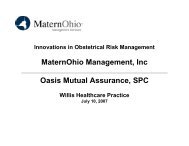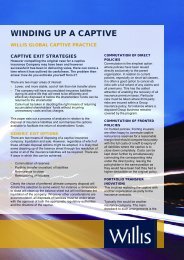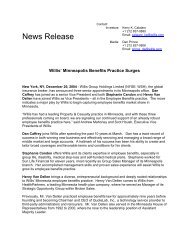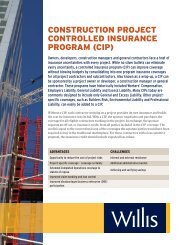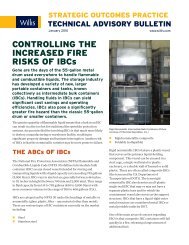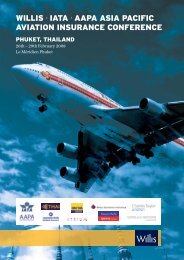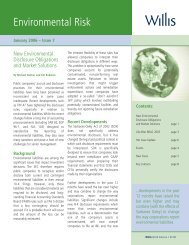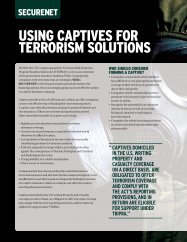global solutions consulting group global solutions consulting - Willis
global solutions consulting group global solutions consulting - Willis
global solutions consulting group global solutions consulting - Willis
Create successful ePaper yourself
Turn your PDF publications into a flip-book with our unique Google optimized e-Paper software.
The enquiries we hear from our clients include:<br />
— Which hazards is our business exposed to on a <strong>global</strong> scale?<br />
— What are the potential Property Damage & Business Interruption<br />
(PD/BI) losses we may face on a regional and/or single site basis?<br />
— How do these compare with our current retention levels, insurance<br />
limits and our general company risk tolerance?<br />
— Can more than one facility be a� ected by the same natural hazard event?<br />
— How exposed are our suppliers?<br />
— What risk mitigation options can we consider to reduce our exposure?<br />
To assist in answering these questions, <strong>Willis</strong> GSCG o� ers the following<br />
services to help identify, evaluate and manage our client’s risks:<br />
Strategic<br />
CAT Review<br />
CAT Modelling<br />
CAT Risk<br />
Engineering<br />
• ASSISTS IN SHAPING<br />
A COMPANY STRATEGY<br />
FOR MANAGING CAT<br />
RISK EXPOSURES<br />
• QUANTIFICATION OF<br />
PORTFOLIO PD/BI LOSSES<br />
• REVIEW OF CURRENT<br />
INSURANCE LIMITS FOR<br />
CAT PERILS<br />
• QUANTIFICATION OF SINGLE<br />
SITE PD/BI LOSSES<br />
• IDENTIFICATION<br />
OF VULNERABILITIES<br />
• RISK IMPROVEMENTS<br />
TO HELP REDUCE FUTURE<br />
LOSSES AND IMPROVE<br />
BUSINESS CONTINUITY<br />
Marc Lehmann<br />
Managing Director<br />
<strong>Willis</strong> GSCG Catastrophe Risk Management<br />
Tel:+44 (0)20 3124 6697<br />
Email: lehmannm@willis.com<br />
Torolf Hamm<br />
Senior Catastrophe Risk Consultant<br />
<strong>Willis</strong> SRS Catastrophe Risk Management<br />
Tel:+44 (0)20 3124 8281<br />
Email: hammt@willis.com<br />
Junsang Choi<br />
Senior Catastrophe Risk Consultant<br />
<strong>Willis</strong> GSCG Catastrophe Risk Management<br />
Tel:+44 (0)20 3124 6352<br />
Email: choiju@willis.com<br />
Sohia Vanderpump<br />
Catastrophe Risk Consultant<br />
<strong>Willis</strong> GSCG Catastrophe Risk Management<br />
Tel:+44 (0)20 3124 8455<br />
Email: vanderpumps@willis.com<br />
Ben Dryne<br />
Senior Catastrophe Risk Consultant<br />
<strong>Willis</strong> Business Risk Solutions, Australia<br />
Tel +613 8681 9802<br />
Email: dryneb@willis.com<br />
<strong>Willis</strong> Limited<br />
The <strong>Willis</strong> Building<br />
51 Lime Street<br />
London, EC3M 7DQ<br />
United Kingdom<br />
Tel: +44 (0)20 3124 6000<br />
www.willis.com<br />
© Copyright 2012 <strong>Willis</strong> Limited.<br />
<strong>Willis</strong> Limited, Registered number: 181116 England and Wales.<br />
Registered address: 51 Lime Street, London, EC3M 7DQ.<br />
A Lloyd’s Broker. Authorised and regulated by the Financial Services Authority.<br />
9496/03/12<br />
GLOBAL SOLUTIONS<br />
CONSULTING GROUP<br />
NATURAL<br />
CATASTROPHE<br />
RISK CONSULTING<br />
GLOBAL SOLUTIONS<br />
CONSULTING GROUP<br />
Recent events around the globe have highlighted<br />
the impact natural hazards can have across wide<br />
geographic regions and the importance for clients<br />
to better understand their risks and exposures.<br />
It has become evident over the past 50 years<br />
that insured and economic losses due to natural<br />
hazards are trending upwards and it is unlikely<br />
this will reverse.<br />
Although natural hazards are considered<br />
rare, when we look at the statistics - most<br />
corporations have a 30% chance of experiencing<br />
an earthquake, fl ood or wind related natural<br />
disaster in the next 20 years. These low<br />
frequency high impact events cause signifi cant<br />
property damage and business interruption to<br />
<strong>global</strong> business operations and ultimately impact<br />
on the company’s profi ts and employees, as well<br />
as damaging reputation and market share.<br />
As part of one of the world’s leading risk<br />
management and insurance intermediaries, <strong>Willis</strong><br />
Global Solutions Consulting Group (GSCG) can<br />
offer a wide range of catastrophe risk <strong>consulting</strong><br />
services to help companies better identify and<br />
quantify their natural hazard risks and assist them<br />
in making more informed decisions to support<br />
their risk transfer and mitigation requirements.
GLOBAL SOLUTIONS<br />
CONSULTING GROUP<br />
STRATEGIC CAT REVIEW<br />
A Strategic CAT Review begins with an Exposure Review to identify where a Client’s assets are<br />
situated geographically in terms of value and number of locations. For key regions the exposures<br />
are mapped to identify clusters (locations in close proximity) that could be a� ected by the same<br />
natural hazard events.<br />
A Natural Hazard Ranking Analysis is then undertaken to provide a fi rst diagnosis of a client’s<br />
peril exposure based on a qualitative and comparative ranking system. This assessment coupled<br />
with the Exposure Review can assist companies in shaping their risk management strategy for<br />
dealing with natural catastrophe issues, so that more informed decisions can be made around<br />
future strategic planning, risk management and acquisition activities. Historic records for<br />
portfolios located in natural hazard prone regions are also provided to support the analysis.<br />
Below are sample outputs from a Strategic CAT Review.<br />
Figure 1.1: Exposure Review<br />
Figure 1.2: Cluster Analysis<br />
Figure 1.3: Natural Hazard Ranking Analysis<br />
Figure 1.4: Historic Events<br />
KEY BENEFITS FROM A STRATEGIC CAT REVIEW<br />
— Promotes awareness of the natural catastrophe hazards to which a company is exposed to on<br />
a <strong>global</strong> basis and the potential impacts.<br />
— Assists companies in shaping their risk management strategy for dealing with natural catastrophes.<br />
— Enables senior executives to make more informed decisions around their business continuity<br />
planning needs, particularly in natural catastrophe prone regions.<br />
Although natural hazards are considered<br />
rare, when we look at the statistics -<br />
most corporations have a 30% chance of<br />
experiencing an earthquake, fl ood or wind<br />
related natural disaster in the next 20 years.<br />
CAT MODELLING<br />
<strong>Willis</strong> GSCG has extensive experience in the use of natural catastrophe models to help clients<br />
quantify their portfolio loss expectancies for varying return periods and perils including<br />
earthquake, windstorm and fl ood. Analyses can be undertaken for both probabilistic and scenario<br />
(single event) losses.<br />
CAT modelling draws together the fi elds of seismology, earthquake engineering, hydrology,<br />
meteorology, atmospheric science, mathematics, statistics, actuarial science and insurance. It is<br />
a highly complex and a sophisticated process and <strong>Willis</strong> GSCG provides our clients access to this<br />
niche and extremely important of area of risk management. A CAT modelling analysis provides<br />
estimates of probable maximum losses for Property Damage and Business Interruption based on<br />
a wide range of possible natural hazard events. Typical outputs include an Exceedance Probability<br />
(EP) curve, as illustrated below.<br />
Figure 2.1: Example evaluation of a simple insurance programme for earthquake, including<br />
the identifi cation of activation and exhaustion levels. This information is used to review<br />
the suitability and competitiveness of the client’s current insurance programme in relation<br />
to natural hazards.<br />
Figure 2.2: Illustrates how the use of additional data and risk mitigation measures can<br />
reduce the modelled loss estimates and potentially allow for premium savings.<br />
KEY BENEFITS FROM A CAT MODELLING ANALYSIS<br />
— Quantifi cation of portfolio loss expectancies for varying return periods and perils including<br />
earthquake, windstorm and fl ood.<br />
— Analyses can capture both probabilistic (multiple events) and scenario based (single event)<br />
loss assessments.<br />
— Clients are able to objectively and scientifi cally review the suitability and competitiveness of<br />
their current insurance programme in relation to natural catastrophe perils.<br />
— Identifi cation of locations contributing the most to the expected losses, so clients can focus their<br />
attention on these high risk facilities as part of their natural catastrophe strategy.<br />
CAT RISK ENGINEERING<br />
For companies with large, individual facilities that are vulnerable to high levels of localised<br />
Property Damage and Business Interruption exposure, <strong>Willis</strong> GSCG can assist by undertaking<br />
detailed natural hazard risk assessments to help identify and quantify the natural hazard risks<br />
at a given facility. This analysis includes the following steps:<br />
1. Detailed quantifi cation of the local hazards for the site.<br />
2. A site visit by our natural hazard risk engineers to inspect the main physical assets<br />
and operations.<br />
— Identifi cation of actual on-site vulnerabilities of the major buildings, process equipment,<br />
stock and on-site utility infrastructure deemed critical for continued operations.<br />
— Literature review and comparison against similar assets that have su� ered damage from<br />
past events.<br />
3. Quantifi cation of the site’s Probable Maximum Loss (PML).<br />
Provision of loss estimates for Property Damage and Business Interruption to assist in risk<br />
transfer decisions and insurance programme structuring.<br />
4. Provision of practical risk improvement measures.<br />
Recommending, where appropriate, cost-e� ective improvement measures to help mitigate<br />
property, operational and life safety risks at the plant.<br />
KEY BENEFITS FROM CAT RISK ENGINEERING<br />
— Detailed PML assessment for a key facility to reduce uncertainty around the modelled losses<br />
by taking into account actual site specifi c vulnerabilities.<br />
— Identifi cation of Risk Improvements (recommendations) to help reduce losses or anticipated<br />
downtime from a natural hazard event.<br />
— Recommendations can also help to improve general Business Continuity and Life Safety<br />
at the plant.



